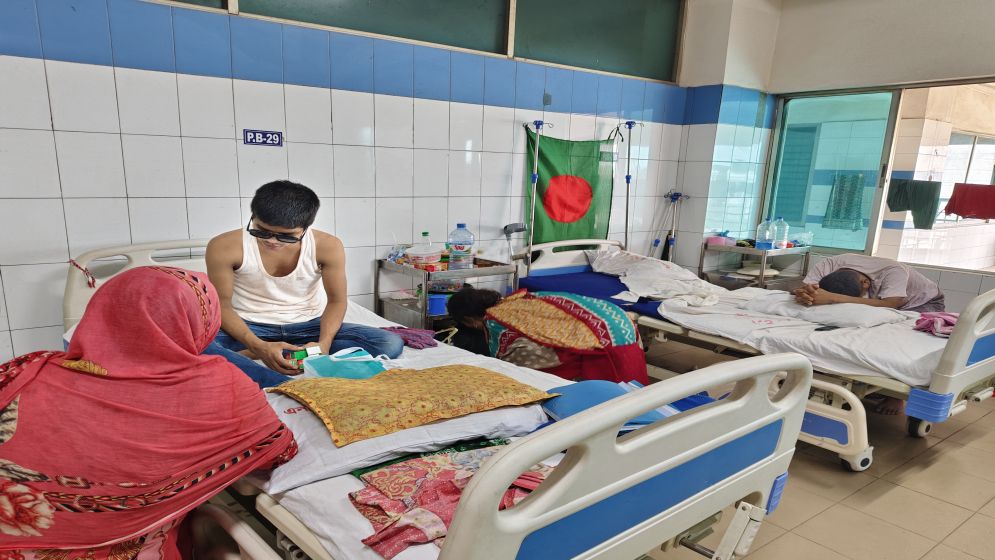Over 500 partially or fully blinded during protests: Dangers of police using pellet guns exposed
UNB
Publish: 17 Sep 2024, 01:40 PM

Dhaka,
September 17 (UNB): On July 19, during the Anti-Discrimination Students
movement, Md. Bappi Hossain, 19, was shot by police in Rayerbazar area of the
capital.
The shotgun round with
which he was shot resulted in five pellets nestling in his eyes - three in the
left and two in the right.
Bappi is admitted at the
specialised dedicated care unit of the National Institute of Ophthalmology and
Hospital in Shyamoli of the capital, commonly known as the 'Chokkhu' or Eye
Hospital, where despite three rounds of surgery, he still cannot see with
either eye.
His mother Maryam Begum
said that there are still 19 shotgun pellets in his body. The doctors have told
her that Bappi will never see again. But somewhere in Bappi's mind there is
still hope that he will regain his sight one day.
Rahmatullah Sarkar
Sabir, 26, was a coordinator of the Anti-Discrimination Students movement at
Barishal BM College. His brother Nazrul Islam told UNB that there was a clash
with the police in front of the college on the afternoon of August 4. At that
time, Rahmatullah was shot.
Three pellets hit his
left eye, while one hit his right eye. He too is admitted at the Eye Hospital.
There is still one pellet in the left eye. Extracting that would require
disposing of the eye itself, doctors said. The right eye has recovered
following surgery, but Rahmatullah can see nothing with his left eye.
According to the
information centre of the National Institute of Ophthalmology, from July 17 to
August 31, 611 people were admitted at the hospital with eye injuries. Among
them, 28 have lost their sight in both eyes. Another 510 have lost the sight in
one eye. Some 177 individuals underwent surgery twice. As of September 12, 46
remain admitted in the specialised dedicated care unit of the hospital. All of
them suffered pellet gun injuries.
Sanjay Kumar, resident
surgeon of the institute, told UNB, "All the patients we came across were
injured by metal pellets. The eye is a very sensitive structure. Like a
football contains air, eyes contain a jelly-like substance and water. The eye
has many layers, one of which is the retina. When the pellet penetrates the
retina and enters the jelly-like substance, the retina is torn, and the
structural integrity of the eye is destroyed. There is little chance of coming
back from there. The reason we do the second operation is because people with
retinal tears, nerve damage, or internal haemorrhage can get better slowly if
they don't have too much damage. But if the damage is beyond a certain point, there
is nothing to be done."
Although authorities
claim they are a non-lethal alternative to firearms that use live bullets,
metal pellet-firing shotguns fire a large number of small pellets spread over a
wide range. Known as "birdshot" (it was originally used in hunting),
the multidirectional spray of pellets is designed to catch prey in flight.
There is no way to control the trajectory or direction of the pellets, whose
effects are therefore indiscriminate.
Depending on their size,
each round will contain 300-600 pellets. By their very nature, the weapons have
a high risk of causing serious and permanent injuries to the persons targeted
as well as to others, which is perhaps why many bystanders were reportedly
injured during the recent protests.
Pellet guns
overwhelmingly blind, injure, and maim, rather than instantly kill. They are
therefore posited as more "humane" and "acceptable"
instruments of crowd control. But Amnesty International considers the use of
birdshot to be absolutely inappropriate for law enforcement and it should never
be used in the policing of protest.
Both Amnesty
International and Human Rights Watch have in recent years called for a ban on
using pellet-firing shotguns in Indian-administered Kashmir. During a mass
uprising there in 2016, more than 1,100 people were partially or fully blinded
by pellets.
While calling for the
ban, Amnesty reported: "People injured by pellet-firing shotguns have
faced serious physical and mental health issues, including symptoms of psychological
trauma. School and university students who were hit in the eyes said that they
continue to have learning difficulties. Several victims who were the primary
breadwinners for their families fear they will not be able to work any longer.
Many have not regained their eyesight despite repeated surgeries."
Many countries have
banned police from using such "ammunition meant for hunting animals"
on human beings. With policing reform high on the agenda for the interim
government, the use of pellet guns for crowd control is an issue that deserves
the authorities' attention.
END/UNB/AJ/ssk
